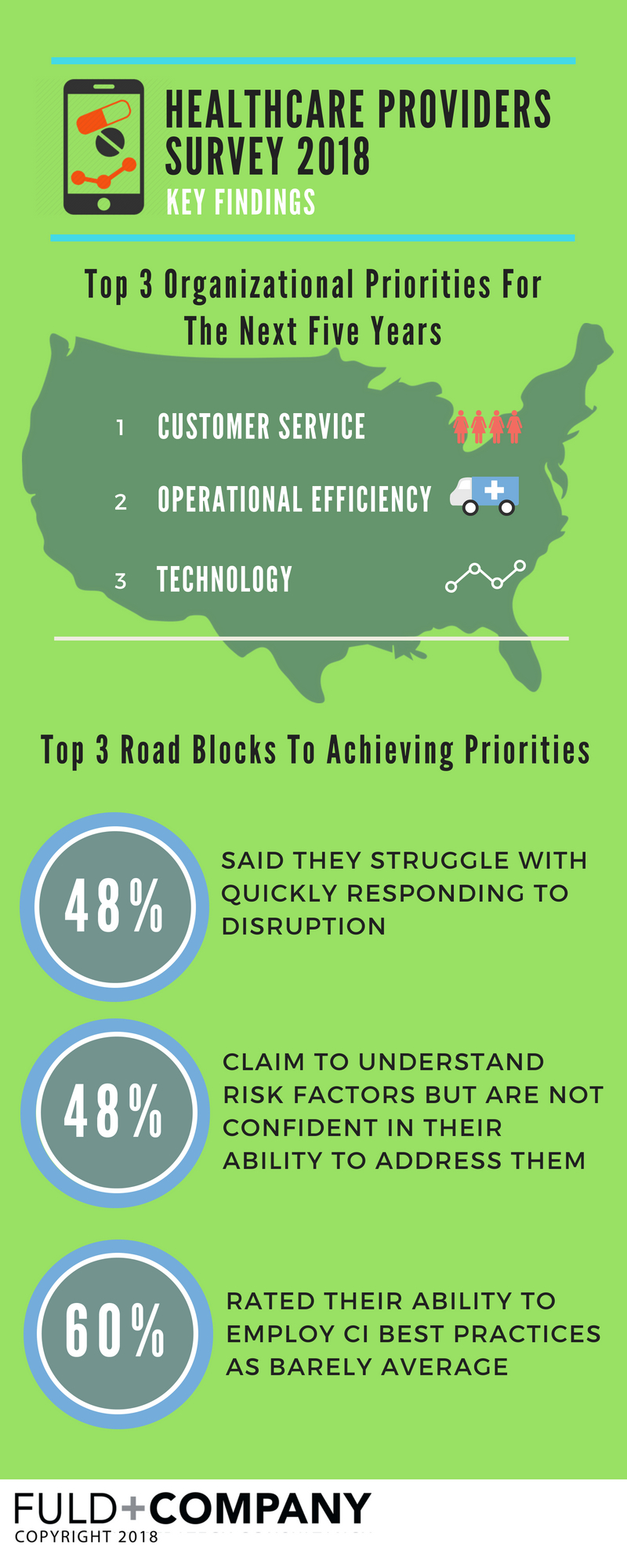Managing Today’s Healthcare Environment – Competitive Assessment, to Strategy, to Execution
Posted by | Fuld & Company
 Previously, we have discussed the proper crafting of strategy in today’s Healthcare industry – identifying the key healthcare topics and external issues driving change, albeit uncertainly, and arguing that major innovations such as the Amazon/Berkshire Hathaway/JP Morgan collaboration will not single handily redefine the industry, although it’s definitely going to have an impact. The next question to consider for Healthcare executives facing such a tumultuous environment is what to actually do.
Previously, we have discussed the proper crafting of strategy in today’s Healthcare industry – identifying the key healthcare topics and external issues driving change, albeit uncertainly, and arguing that major innovations such as the Amazon/Berkshire Hathaway/JP Morgan collaboration will not single handily redefine the industry, although it’s definitely going to have an impact. The next question to consider for Healthcare executives facing such a tumultuous environment is what to actually do.
A good physician will advise his or her patients, “If you don’t check for it, you won’t know how to act on it.” Ironically, the healthcare industry is falling short on its own advice. A recent survey conducted by Fuld & Company to capture the attitudes and actions of executives in payer and provider companies across the US demonstrates that 60% of senior executives acknowledge a major gap, namely execution of their organization’s plans. Their concern – that deficiency can mean the difference between mere survival and success.
Part of the execution deficit is due to confusion about the external environment. More than 50% of respondents admitted to discounting the need for rigorous understanding of the coalescence, technological advancements, public policy, and other strategic shifts, presumably relying on intuition and internal consensus to craft strategy. Without the underlying data and evidence-based conclusions derived through techniques such as market analysis, competitor analysis, competitive intelligence, and scenario planning workshops, such strategy is inherently amorphous and incapable of being executed.
We observed in the survey responses, our engagements with Fortune 500 clients and in our assessment of trending healthcare topics, a lack of action-orientation or capability on four primary areas of transformation. We call these the four freshly brewing B’s.
Healthcare Topic #1: Blurring Silos
The US healthcare industry is coalescing, and sectors are merging. This year’s announced health-care mergers and acquisition transactions include Haven Behavioral Healthcare and Acute Care Hospital, Takeda and Shire, Celgene Corporation and Juno Therapeutics, SSM Health and Agnesian Healthcare, already passing the $150 billion mark. Activity during the first quarter had not been reached in twelve years. Since it impacts us all, such an accelerated amalgamation requires conducting structured analysis, crafting of cogent strategy, and undertaking focused execution.
Traditionally, the sectors have worked in silos. Behavioral health was a dedicated discipline operating somewhat apart from a hospital’s other units and pharmaceutical research and development was managed strictly along therapeutic area lines. Today’s vertical and horizontal integration will force organizations to analyze the new competitive set using structured analytic techniques and draw substantiated conclusions from which it can devise strategies. Execution will need to focus on creating new points of differentiation, re-structuring operations to respond to the new reality in the external environment.
For large organizations, this process of evolution can be painful. In our survey, 51% of respondents characterize decision-making in their organizations as a consensual, slow, and tiring effort. To gain advantage in the new, congealing marketplace, execution must run at a quicker pace. That only comes when companies analyze the healthcare topics in a structured manner, develop distinct strategies, and clarify action across formerly independent silos.
Healthcare Topic #2: Big Data
Data in healthcare, as in other industries, is the new point of leverage. Payer, provider, and life science organizations are adopting advanced data mining techniques to inform activities across the spectrum, from research and development, commercialization, to patient care. This dynamic is especially visible in hospital management systems. North York General Hospital in Canada established real-time analytics to improve patient outcomes and develop a deeper understanding of the operational factors driving its business, an adoption that IBM recognizes as an early successful use case. Increasingly, executives are equipping their organizations with advanced analytics; in fact, 47.2% of our survey respondents say they are using them.
However, an equal percentage said they don’t have counter-strategies ready to tackle competitor moves fueled by Big Data, another example of a significant gap in action planning. One way to create counter-strategies and effective action plans in light of competitors’ adoption of Big Data is not through blind quantitative surveys of one’s own, but through qualitative analysis of competitors’ goals, methods, and uses of data. Again, the lack of evidence-based conclusions hampers effective competitive execution.
Healthcare Topic #3: Better Technology
Today’s technological revolution is bound to save billions of dollars in spending in the healthcare sector. Our survey confirmed that organizations are prioritizing customer service and partner-relations as they move from fee for service to a value-based healthcare system, a move that is being facilitated by the advancement of technology and digital capabilities. The shift is real. The Health Care Transformation Task Force, coalition of payers-providers, has committed to move 75% of its revenues to value-based reimbursements by 2020. Technology is the way to achieve the triple goal for healthcare – decreased cost, improved quality, and enhanced experience.
For established players in the health industry, this shift again requires action, which again, in turn, requires an understanding of the elements of the shift. Techniques such as scenario-based planning are valuable here, as the complexity of the change and the uncertainty in timing, technology, new players, and outcomes require creativity and probing. Such a structured approach to understanding the external environment leads to the formation of a framework for monitoring identified indicators of change. From this process, organizations are armed to efficiently track marketplace activities and execute plans in an accountable manner.
Healthcare Topic #4: Bending Policies
Every new presidential turn seemingly introduces a new set of policies and plans for the healthcare system. At the very least politics is amplifying the rhetoric. 48% of our survey respondents state they struggle to harness the right resources for timely execution surrounding what many seem as a confused, dogmatic regulatory system. On the payer side, the state-based regulatory structure has a profound impact on fees and margins; state oversight has tremendous bearing on provider’s operations and investments.
Yet, it is the federal intervention in the market that causes the greatest turbulence. For instance, the Tax Cuts and Jobs Act which repealed the Obamacare tax on those who don’t get health insurance, was estimated to cause 13 million people to drop out of the system. The result – an increase in healthcare costs with more uninsured and a decreased ability to pool risks for greatest effectiveness.
Population health management systems (PHM), strategies discussed in-depth in Fuld & Company’s paper on HealthCare Convergence, appear to be the best opportunity for market forces to advance in light of political uncertainty. Like the issue of Better Technology, this element is vast and seemingly ever-evolving, and requires organized frameworks to assess, plan for, and execute against. Focusing on market forces in light of the political rhetoric is admittedly an intricate task. Yet, scenario-based planning, war gaming, and similar techniques can help organizations simulate the variety of market factors and craft plans with contingencies. The insights gained place an organization ahead of its competitors and allow it to anticipate possibilities, even those of two- and four-year political intervals.
Disruption in the Health Industry is Obviously Here
Mergers and acquisitions, big data, advancing technology, and public policy are prime healthcare topics and the four primary dimensions of this disruption, dimensions that executives need to assess critically, plan for and execute against with the help of our health and life science consulting practice.
Yet 66% of our respondents rated their performance as “Average” on what is a critical capability in a tumultuous environment – “Quick and effective decision making.” The lack of cohesion from assessment to plan to execution marks numerous business failures such as Blockbuster, RIM, Polaroid, and others, and respondents’ admission of their lack of capability makes one wonder which firms may be casualties of today’s environment.
In 2013, more than $700 billion of US medical spending was calculated to have been wasted on services, costs, administration and fraud. Effective decision making would help decrease this waste. Practices such as assessing competition and understanding differentiation would also help refine business operations; yet, more than 50% of respondents to our survey again rated themselves and their companies as “Average” on these capabilities.
Even in a complex, multi-faceted, and turbulent industry, organizations can arm themselves with value propositions, business models, and product and service offerings that contribute to success. Doing so begins with a full assessment of the market landscape, including competitors, as well as mergers, data, technology, and policy. It is only with tangible, substantiated, and authenticated conclusions that an organization can craft strategy and enjoy the benefits of effective execution.
Tags: Competitive Intelligence, Competitive Strategy, Data, Health & Life Science, Information Technology, Mergers & Acquisition, Risk Management, Robert Flynn
















